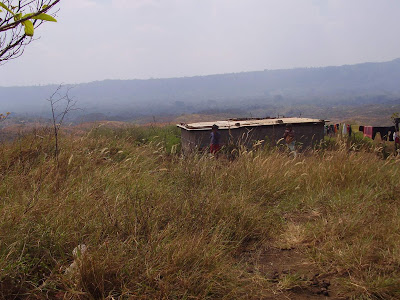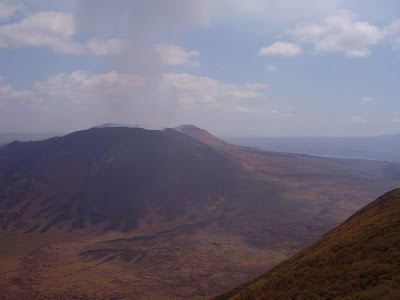The project revisited. We’re moving
The most crucial element for my work was meeting between the local people (lay perspective) that live under the volcanoes and the experts (like geologists, medical stuff and so). By this I wanted to see how those two groups are interacting with each other and how the communication/transmitting/translation of the scientific data is going. I wanted to investigate differences in the perception of the nature, danger, risk and health issues. I didn’t want to compare those (it’s both a time issue and experience I obviously lack), but rather see how they coexist in the given situations like evacuation (also forcible), education projects, campaigns and information about the geological hazards. That is why I needed a real meeting between the experts and the lay and I wanted to participate in such. While writing a project it seemed easy to carry out this task, but when I came here things began to look different. After conversations with some specialist (both geologist, volcanologists, doctors and representatives of the Red Cross, Ministry of Health, Defence and others that have something to do with the natural disasters) I realized that people actually don’t meet the representatives of the “scientific world”, and definitely don’t deal with “scientific data” as I had thought. It meant that I would need to spend more time with those groups separately and then make some comparison. I don’t think I have time to this. Neither I feel like doing this kind of fieldwork. It was so easy to imagine the conflicts and the dynamics when I was just reading some reports from the education programmes and so. It’s not the case. Well, maybe it would be if I could participate in some of those programmes, but there are not any right now and I didn’t want to risk that I would be sitting and waiting for anything to happen.
The other problem was that the health issues don’t seem to be so important/dramatic as I had supposed after reading some reports (for instance SINAPRED’s reports). I was explained at one meeting: “Those reports are focused at only one case and it can look really terrifying when you are reading them, but it isn’t so. Additionally, when doing reports about risks in the area we base on the worst scenario. It can be dangerous, but doesn’t have to be. And if nothing happens, nothing happens”. It’s also a finding – the politics of the information available to the public, but I can’t take up every aspect and phenomenon I discover here, right? And because I wasn’t interested in POSSIBLE ERUPTIONS, but in a CONSTANT HEALTH HAZARDS I was in a fix. Wanting to stay near my (written) project I had some alternatives:
1. The first one was staying in Leon and doing fieldwork about people’s experience with the eruptions in the past and their feelings about possibility/probability of the eruption. I had taken this plan B into consideration before leaving Norway in case of what I had described above, but I really don’t feel any passion for this kind of “probabilistic” investigation. Well, the results can be interesting, but I am so influenced by Douglas and Wildavsky’s idea about “the risks that are socially constructed” that I feel strange to ask people “Aren’t you really afraid of living here?”. I addition I think that this kind of question is so ethnocentric that I just couldn’t base my work on them. Also, I didn’t want to fall into a trap of using place identity to explain every phenomenon (like risk perception and management). Maybe I will have to – but I don’t want to take anything for granted.
2. Moving to the capital and working only with the group of experts. I want to make such a study some day, but for now I feel that I’m not brave enough to talk with those people. In my opinion this kind of study requires a lot of self-confidence. You have to be able to talk freely with people that have some kind of specialized knowledge and not necessarily are interested with sharing it and, what makes it more difficult, belong to the same epistemological system as you do (I really assume that this is the case). And of course I wasn’t prepared for this kind of work, both mentally and theoretically (I do love Bruno Latour, but he scares me to death!:) I had no idea how I could change my project and use it to a new study. I didn’t have time to write/think a new one. I really felt paralyzed by my previous writing, plans I had made and, of course, by my expectations. “It could be so great if it was like in my paper”, I thought. But It wasn’t and I had to do something with this.
Luckily, I turned out to be a textbook example for the fieldworker that can say: “A lot on the fieldwork depends on coincidence!” During the workshop with INETER (governmental institute for geosciences) in Managua one of my contact persons suggested that I should try to go and visit Masaya volcano south from the capital. I was said that “People there are living in the gases! You can see it, you can smell it. It’s a constant risk and people live there. And there are still people who are moving in there. I don’t know why. And nobody does anything with this case”. I got a brainwave! How could I miss this volcano, why nobody has told me about this case before, why haven’t I found any report about this case?!?! Is it really truth that nobody makes an investigation of the influence of the gases on the people that are living there? I felt myself getting goose pimples all over and finally I felt something I needed – a real interest. INETER organized an excursion and next day we went there.






Do you see the gas plume?

(No, it´s not so bad quality of the pictures, it´s a cloud of volcanic gases)
Later, when I asked one person about why there is no medical investigation done there, he laughed and said that “maybe because they want people to die calm”. I don’t know if it’s true that nobody makes research in this zone. Tomorrow I have a meeting with somebody from the Medical Department at the UNAN (University in Managua) and will surely ask:).
Anyway, we came back home to Leon and packed our stuff (God, how much I managed to collect in one month!!!) and moved to Masaya that is about 120 km from our previous location. Next day we went round the volcano and find a room in La Concepción (popularly known as La Concha) that is about 10 km from the maximal affected zone. Finally I feel that my work has began, although I am still a little bit confused what my next step should be, but I’m really excited and I feel that this place is a right one for us.

<< Home